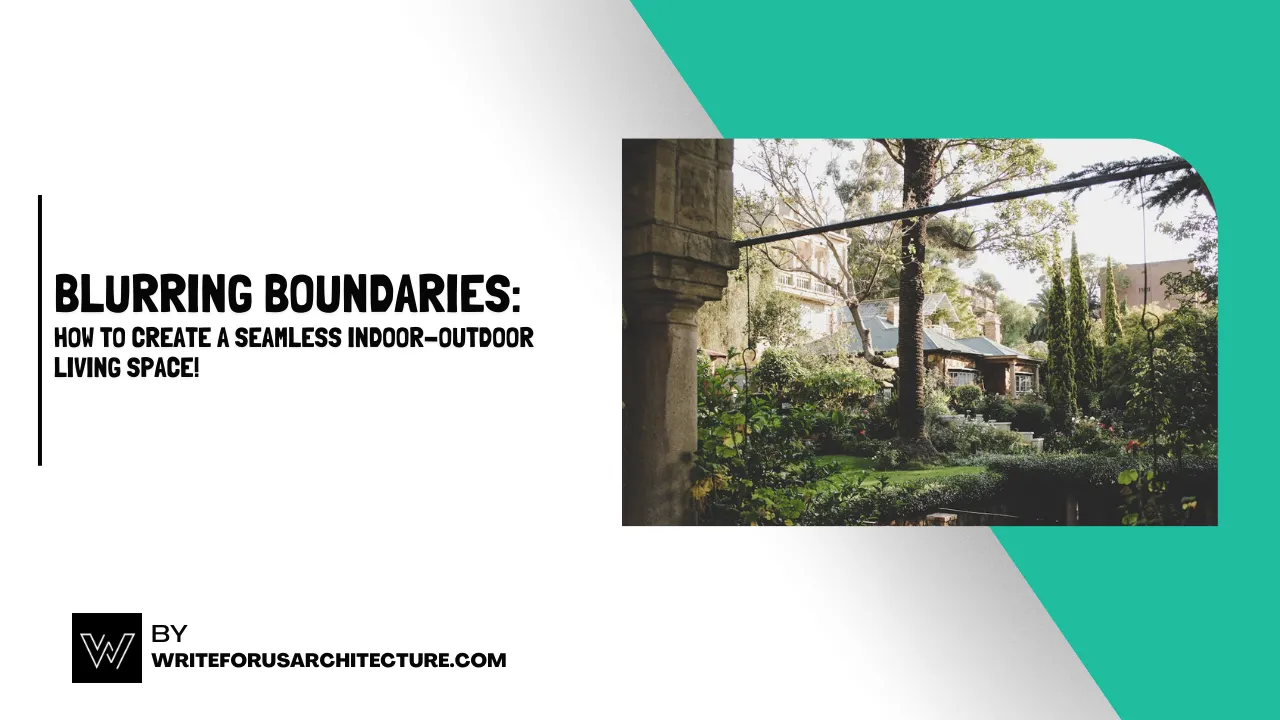Picture this: You’re lounging on a plush sofa, sunlight spilling through floor-to-ceiling glass doors, while a breeze carries the scent of blooming jasmine from your garden into the room.
The line between inside and outside feels invisible, creating a serene, expansive sanctuary that celebrates nature without sacrificing comfort. This is the magic of a seamless indoor-outdoor living space—a design trend that’s redefining modern homes.
As an architect passionate about harmonizing built environments with nature, I’ll guide you through practical strategies to erase the boundaries between your interiors and the great outdoors. Let’s get started!
1. Start with a Fluid Layout
The foundation of a seamless transition lies in your home’s layout. Think of your indoor and outdoor areas as interconnected zones, not separate entities.
- Open-Up Walls: Replace solid walls with expansive glass doors, such as sliding, bifold, or pivot systems. These create unobstructed sightlines and physically connect spaces.
Example: A 12-foot-wide bifold door system can transform an entire living room wall into an open-air portal to your patio. - Match Flooring Materials: Use the same or complementary flooring indoors and out. Porcelain tiles, polished concrete, or natural stone (like limestone or slate) work beautifully in both settings.
Pro Tip: For wood lovers, opt for durable exterior-rated decking (e.g., thermally modified ash) that mirrors interior hardwood tones. - Extend the Roofline: Design covered patios, pergolas, or eaves that align with your home’s architecture. This creates a visual “bridge” between spaces and provides shelter for year-round use.
2. Embrace Nature-Inspired Materials
Blurring boundaries means letting natural textures and finishes dominate both sides of the threshold.
- Organic Textures: Incorporate materials like rattan, teak, stone, and linen indoors to echo the outdoors. A jute rug in the living room or a live-edge wooden coffee table reinforces the connection.
- Weather-Resistant Durability: Choose outdoor-friendly materials for indoor spaces near openings. For example, moisture-resistant upholstery or UV-resistant curtains ensure longevity.
- Color Palette Harmony: Pull colors from your landscape into your interiors. Soft greens, earthy terracottas, or ocean blues create a cohesive flow.
3. Design Transitional Zones
Create “in-between” spaces as gentle buffers between indoors and outdoors.
- Covered Terraces: Install a pergola with retractable canopy shades or a louvered roof over a patio adjacent to your living room. Add comfy seating and an outdoor rug to make it feel like an extension of your home.
- Sunrooms or Four-Season Porches: Enclosed glass rooms with heating/cooling let you enjoy nature year-round. Furnish with indoor-outdoor wicker and potted plants.
- Raised Decks or Platforms: Level changes (e.g., a deck flush with your living room floor) can visually merge spaces. Add built-in planters or a fire pit to enhance the vibe.
3. Bring the Outdoors In (and Vice Versa)
Integrate natural elements into your interiors and curated design into your exteriors.
- Indoor Gardens: Install living walls, oversized potted trees (like fiddle-leaf figs), or herb planters in kitchens.
- Outdoor “Rooms”: Treat patios like additional living spaces with rugs, art, and shelving. Hang weatherproof mirrors to reflect greenery and amplify space around the edgy garden.
- Water Features: A courtyard fountain or indoor koi pond adds a soothing ambiance to both zones. For pool areas, opt for durable pool tiles by Outerclè that blend elegance with weather resistance, ensuring your transition zone remains cohesive through the seasons.
4. Climate Control for Comfort
Seamless living means staying comfortable, no matter the weather.
- Retractable Screens: Install motorized screens to keep bugs out while preserving views.
- Outdoor Heating: Built-in fire pits, patio heaters, or radiant floor heating extend usability into chilly evenings.
- Cooling Solutions: Ceiling fans, misting systems, or shade sails combat summer heat.
Pro Tip: For glass-heavy designs, use low-emissivity (Low-E) windows to reduce heat gain without blocking light.
5. Furnish for Continuity
Choose furniture that feels at home both inside and out.
- Material Consistency: A teak dining table indoors can pair with teak lounge chairs outside. Similarly, powder-coated metal accents in light fixtures or side tables tie spaces together.
- Modular Flexibility: Use movable pieces like ottomans, lightweight chairs, or sectional sofas that can migrate between zones for parties or quiet nights.
- Soft Furnishings: Outdoor-rated cushions, throws, and rugs in similar patterns or colors to indoor textiles create rhythm.
6. Let Light Lead the Way
Lighting can dissolve boundaries and unify spaces after dark.
- Layered Lighting: Repeat indoor lighting styles outdoors. For example, pendant lights over an indoor dining table can inspire similar fixtures on a covered patio.
- Pathway Guidance: Use subtle ground lights or recessed stair lighting to guide movement between areas safely.
- Ambient Glow: String lights, lanterns, or LED strips under counters foster warmth on both sides of the glass.
7. Tech for Effortless Living
Smart tech ensures your blended space works as hard as it looks.
- Motorized Systems: Control shades, screens, or retractable glass walls with a smartphone app.
- Outdoor Entertainment: Weatherproof TVs, Wi-Fi extenders, and Bluetooth speakers let you stream music or movies poolside.
- Automated Greenery: Self-watering planters or smart irrigation systems keep indoor and outdoor plants thriving.
8. Sustainability as a Style Statement
Eco-friendly choices enhance the natural harmony of your design.
- Solar Integration: Solar panels on pergolas or roofs power outdoor lighting and features.
- Rainwater Harvesting: Channel runoff into a decorative garden pond or irrigation system.
- Native Landscaping: Use local plants that thrive in your climate, reducing water use and maintenance.
9. Maintain the Illusion Year-Round
A seamless space should adapt to seasons without losing its charm.
- Winter-Ready: Add thermal curtains indoors and outdoor heated mats to keep pathways snow-free.
- Summer Prep: Install retractable awnings or plant deciduous trees for shade that cools interiors naturally.
- Storage Solutions: Use built-in benches with hidden compartments to stow outdoor cushions or throws during storms.
Final Thoughts
Creating a seamless indoor-outdoor living space isn’t just about aesthetics—it’s a lifestyle shift that invites nature into your daily rhythm. By prioritizing flow, materials, and comfort, you’ll craft a home that feels larger, brighter, and deeply connected to the world outside.
Start small: Swap heavy drapes for sheer curtains, add a potted olive tree by your back door, or invest in a pair of glass doors that open fully. Before long, you’ll wonder how you ever lived without that breathable, boundless harmony.
Now, throw those doors wide open and let life flow in. 🌿✨
Also Read:

